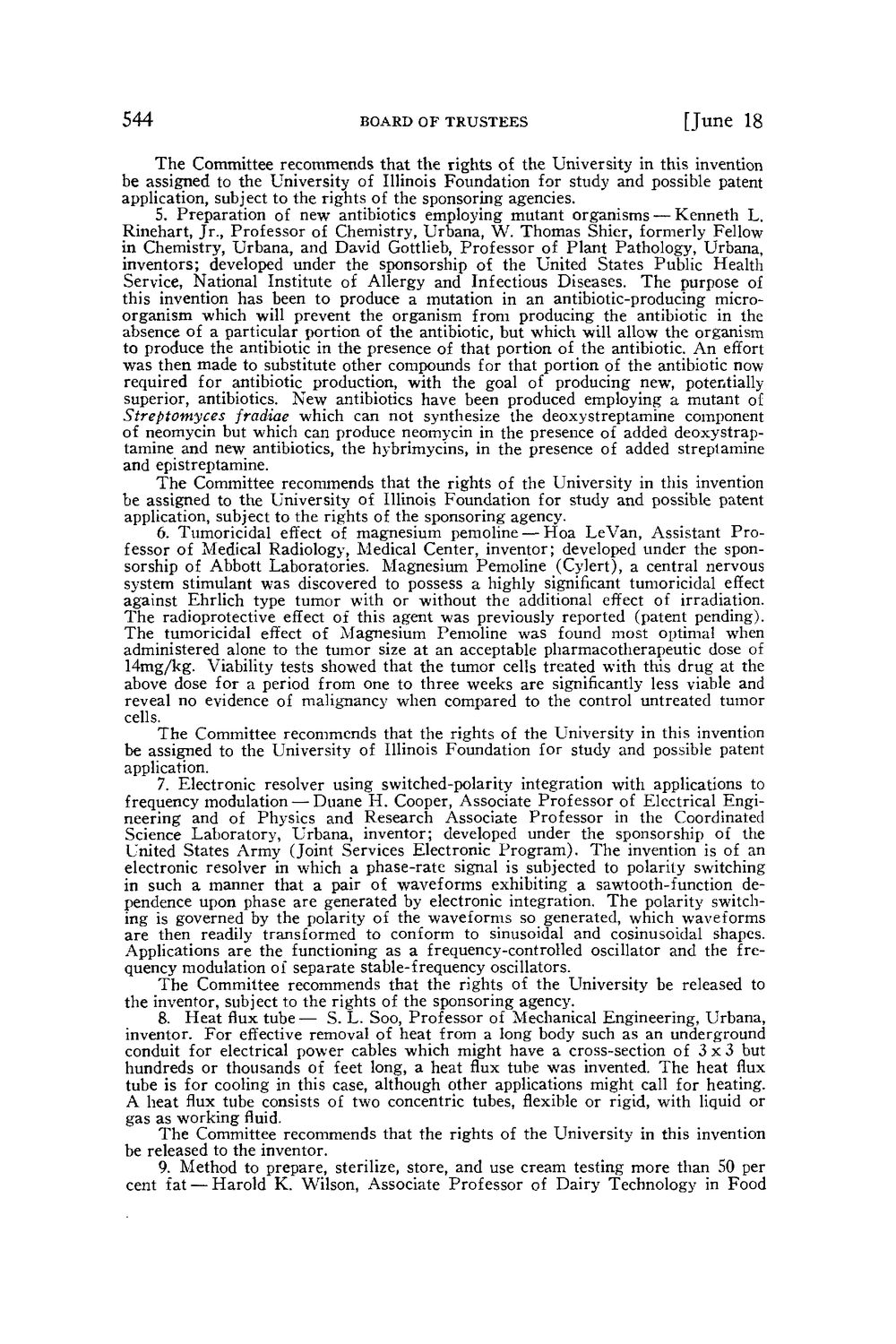| |
| |
Caption: Board of Trustees Minutes - 1970
This is a reduced-resolution page image for fast online browsing.

EXTRACTED TEXT FROM PAGE:
544 BOARD OF TRUSTEES [June 18 The Committee recommends that the rights of the University in this invention be assigned to the University of Illinois Foundation for study and possible patent application, subject to the rights of the sponsoring agencies. 5. Preparation of new antibiotics employing mutant organisms — Kenneth L. Rinehart, Jr., Professor of Chemistry, Urbana, W. Thomas Shier, formerly Fellow in Chemistry, Urbana, and David Gottlieb, Professor of Plant Pathology, Urbana, inventors; developed under the sponsorship of the United States Public Health Service, National Institute of Allergy and Infectious Diseases. The purpose of this invention has been to produce a mutation in an antibiotic-producing microorganism which will prevent the organism from producing the antibiotic in the absence of a particular portion of the antibiotic, but which will allow the organism to produce the antibiotic in the presence of that portion of the antibiotic. An effort was then made to substitute other compounds for that portion of the antibiotic now required for antibiotic production, with the goal of producing new, potentially superior, antibiotics. New antibiotics have been produced employing a mutant of Streptomyces fradiae which can not synthesize the deoxystreptamine component of neomycin but which can produce neomycin in the presence of added deoxystraptamine and new antibiotics, the hybrimycins, in the presence of added streptamine and epistreptamine. T h e Committee recommends that the rights of the University in this invention be assigned to the University of Illinois Foundation for study and possible patent application, subject to the rights of the sponsoring agency. 6. Tumoricidal effect of magnesium pemoline — Hoa LeVan, Assistant Professor of Medical Radiology, Medical Center, inventor; developed under the sponsorship of Abbott Laboratories. Magnesium Pemoline (Cylert), a central nervous system stimulant was discovered to possess a highly significant tumoricidal effect against Ehrlich type tumor with or without the additional effect of irradiation. The radioprotective effect of this agent was previously reported (patent pending). The tumoricidal effect of Magnesium Pemoline was found most optimal when administered alone to the tumor size at an acceptable pharmacotherapeutic dose of 14mg/kg. Viability tests showed that the tumor cells treated with this drug at the above dose for a period from one to three weeks are significantly less viable and reveal no evidence of malignancy when compared to the control untreated tumor cells. The Committee recommends that the rights of the University in this invention be assigned to the University of Illinois Foundation for study and possible patent application. 7. Electronic resolver using switched-polarity integration with applications to frequency modulation — Duane H . Cooper, Associate Professor of Electrical Engineering and of Physics and Research Associate Professor in the Coordinated Science Laboratory, Urbana, inventor; developed under the sponsorship of the United States Army (Joint Services Electronic Program). The invention is of an electronic resolver in which a phase-rate signal is subjected to polarity switching in such a manner that a pair of waveforms exhibiting a sawtooth-function dependence upon phase are generated by electronic integration. The polarity switching is governed by the polarity of the waveforms so generated, which waveforms are then readily transformed to conform to sinusoidal and cosinusoidal shapes. Applications are the functioning as a frequency-controlled oscillator and the frequency modulation of separate stable-frequency oscillators. The Committee recommends that the rights of the University be released to the inventor, subject to the rights of the sponsoring agency. 8. Heat flux tube — S. L. Soo, Professor of Mechanical Engineering, Urbana, inventor. For effective removal of heat from a long body such as an underground conduit for electrical power cables which might have a cross-section of 3 x 3 but hundreds or thousands of feet long, a heat flux tube was invented. The heat flux tube is for cooling in this case, although other applications might call for heating. A heat flux tube consists of two concentric tubes, flexible or rigid, with liquid or gas as working fluid. The Committee recommends that the rights of the University in this invention be released to the inventor. 9. Method to prepare, sterilize, store, and use cream testing more than 50 per cent fat — Harold K. Wilson, Associate Professor of Dairy Technology in Food
| |